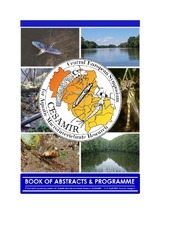Приказ основних података о документу
Trout farm effect on antioxidative defense in Dinocras megacephala (Plecoptera: Perlidae) larvae
| dc.contributor | Mauchart, Péter | |
| dc.contributor | Csabai, Zoltán | |
| dc.creator | Bjelanović, Katarina | |
| dc.creator | Živić, Ivana | |
| dc.creator | Stojanović, Dalibor | |
| dc.creator | Todorović, Dajana | |
| dc.creator | Mirčić, Dejan | |
| dc.creator | Filipović, Aleksandra | |
| dc.creator | Perić Mataruga, Vesna | |
| dc.date.accessioned | 2020-12-01T15:12:55Z | |
| dc.date.available | 2020-12-01T15:12:55Z | |
| dc.date.issued | 2014 | |
| dc.identifier.uri | https://radar.ibiss.bg.ac.rs/handle/123456789/4013 | |
| dc.description.abstract | Trout production represents one of the major agricultural activities in the first and second order streams of Serbia. Organic compounds are drained into the environment usually without previous sedimentation and thus affect stream biota. Since biological monitoring is commonly based on aquatic macroinvertebrates, we used Dinocras megacephala (Klapálek, 1907) larvae as the target organism in order to estimate trout farm effects on physiological stress. Four localities were chosen at the channel of the Raska River (in the vicinity of Novi Pazar, Serbia), two upstream localities and the other two downstream from the trout farm outlet. Specimens were collected with tweezers and placed in liquid nitrogen for further analysis. Basic physical and chemical water parameters were measured directly in the field: temperature, dissolved oxygen, pH and conductivity, and in the laboratory: total phosphorus (TP), orthophosphates (OP) and ionized ammonia (NH4+). Even though the temperature stayed quite constant along the water course (11.1°C to 11.2°C), oxygen concentration decreased from the reference localities (10.4 mg/l and 11 mg/l) to the downstream localities (7 mg/l and. 8 mg/l). Also, the concentration of ionized ammonia was almost ten times higher at the same localities (from 0.0319 and 0.0288 mg/l to 0.3141 and 0.2423 mg/l). The activity of superoxide dismutase (SOD), catalase (CAT) and the total glutathione amount (GSH) were analyzed in order to determine the level of oxidative stress caused by the increase of organic compounds originating from the trout farm. The activity of SOD and CAT enzymes was significantly higher in the samples collected the both downstream localities. Total glutathione amount (GSH) decreases in the specimens collected at the first downstream locality, while the level of enzyme activity at the second downstream locality coincides with the samples from both upstream localities. The results indisputably indicate that higher concentration of organic compounds from the trout farm induce the significant increase of the oxidative stress in the examined species. | en |
| dc.language.iso | en | sr |
| dc.publisher | Pécs, Hungary: University of Pécs Medical School Press | sr |
| dc.relation | info:eu-repo/grantAgreement/MESTD/Basic Research (BR or ON)/173027/RS// | sr |
| dc.rights | openAccess | sr |
| dc.source | 1st Central European Symposium for Aquatic Macroinvertebrate Research | sr |
| dc.title | Trout farm effect on antioxidative defense in Dinocras megacephala (Plecoptera: Perlidae) larvae | en |
| dc.type | conferenceObject | sr |
| dc.rights.license | ARR | sr |
| dcterms.abstract | Перић Матаруга, Весна; Стојановић, Далибор; Филиповић, Aлександра; Мирчић, Дејан; Тодоровић, Дајана; Бјелановић, Катарина; Живић, Ивана; | |
| dc.rights.holder | © 2014 by the University of Pécs, Medical School Press | sr |
| dc.description.other | Mauchart P, Csabai Z, editors Book of abstracts & programme: 1st Central European Symposium for Aquatic Macroinvertebrate Research; 2014 Apr 10‐13; Szarvas, Hungary. Pécs, Hungary: University of Pécs, Medical School Press; 2014. p. 33. | en |
| dc.citation.spage | 33 | |
| dc.citation.epage | 34 | |
| dc.type.version | publishedVersion | sr |
| dc.identifier.fulltext | https://radar.ibiss.bg.ac.rs/bitstream/id/7829/JointSymposia_Pecs-Szaravs_2014-33.pdf | |
| dc.identifier.rcub | https://hdl.handle.net/21.15107/rcub_ibiss_4013 |

